|
GUATEMALA OVERVIEW
Based upon ten very successful expeditions to Costa Rica in 2004-2010 and one to Belize, Hilton Pond Center for Piedmont Natural History--in conjunction with Holbrook Travel--is for the first time offering an exciting and educational field trip in 2011 to study Ruby-throated Hummingbirds on their wintering grounds in Guatemala. Plus, we're returning to Costa Rica and Belize for two excursions and--also for the first time--will take a group of hummingbird enthusiasts to Nicaragua! Join us this year as we "follow the hummingbirds north" in spring migration.
Ruby-throated Hummingbirds, Archilochus colubris--which occur in 38 U.S. states and across southern Canada from March through October-- are the most widely distributed hummingbird species. Nonetheless, they are poorly studied in Mexico and Central America where they spend their non-breeding months. During our 2011 nine-day field trip to Guastatoya in Guatemala's Progreso Province, Center director Bill Hilton Jr. will teach participants how hummingbirds are observed, captured, banded, and released. As "citizen scientists," participants will play integral roles in conducting field work, will visit diverse habitats, and will learn about fascinating aspects of Guatemalan natural history and culture--from cloud forests to semi-arid valleys, from nocturnal mammals to tropical insects. are the most widely distributed hummingbird species. Nonetheless, they are poorly studied in Mexico and Central America where they spend their non-breeding months. During our 2011 nine-day field trip to Guastatoya in Guatemala's Progreso Province, Center director Bill Hilton Jr. will teach participants how hummingbirds are observed, captured, banded, and released. As "citizen scientists," participants will play integral roles in conducting field work, will visit diverse habitats, and will learn about fascinating aspects of Guatemalan natural history and culture--from cloud forests to semi-arid valleys, from nocturnal mammals to tropical insects.
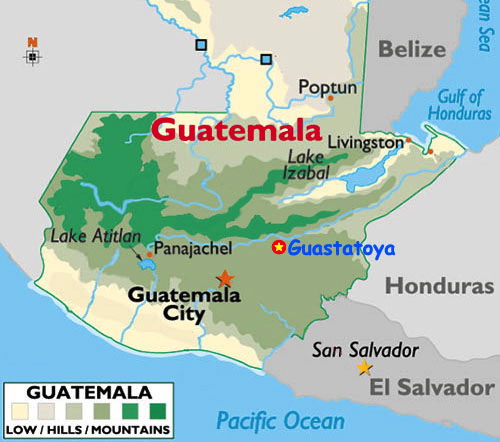
All text, maps & photos © Hilton Pond Center
Guastatoya is in east-central Guatemala (see map above) about 45 miles northeast of Guatemala City; it is the capital of El Progreso Province. The town (photo of main thoroughfare, below) has a 2002 census population of about 11,000 and sits in an east-west valley at an elevation of about 1,850 feet.
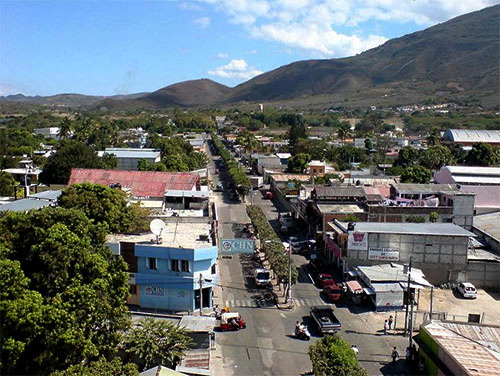
All text, maps & photos © Hilton Pond Center
Our nine-day Guatemala expedition is scheduled to be based at Hotel Casa Guastatoya, used by business travelers and tour companies because of its accommodations, food, and proximity to Guatemalan nature locales. All rooms are simple but comfortable with air conditioning, hot and cold running water, clean towels daily, private indoor toilets and showers, single and/or double beds, and TV; the dining room offers fresh fruit, meats, and vegetables at every meal.
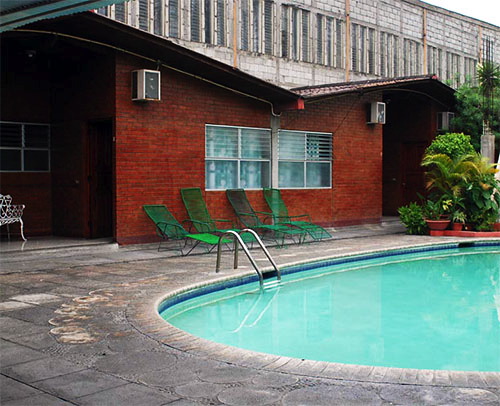
All text, maps & photos © Hilton Pond Center
Casa Guastatoya, which has a swimming pool (above) in which to relax after a morning in the field, is a modest hotel situated on the town's central park. Banks, ATMs, restaurants, Internet cafes, and drug stores are within close walking distance. The hotel is about a 20-minute ride from our study site, to which we travel via air-conditioned tour bus.
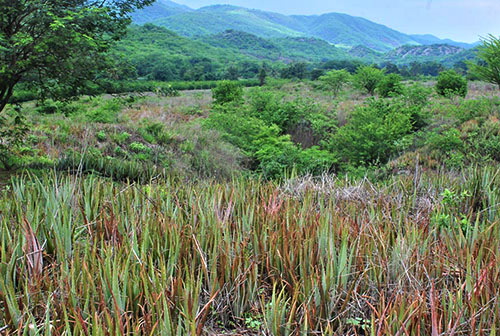
All text, maps & photos © Hilton Pond Center
Our Guastatoya study site is a 35-acre Aloe Vera plantation (above) operated by Alfredo Oliva Véliz, who likewise owns the aloe fields in which we band hummingbirds in Costa Rica. Alfredo's Guatemalan finca is a bit hillier than the one down in Guanacaste Province; it also includes adjoining acreage with more than a thousand Lime trees. The fields where we will spend mornings catching and observing hummingbirds are almost always sunny in February; temperatures there go from mid-70s at 7 a.m. to near 90 at about 11:30 a.m. when we usually quit for the day. Near the field is a small hacienda for getting out of the sun.
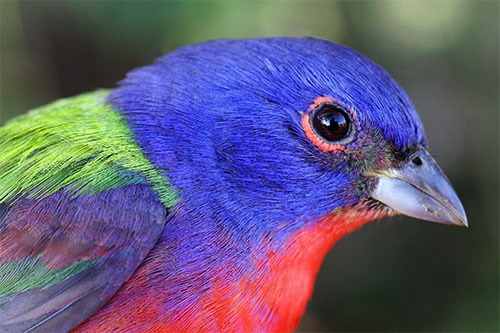
All text, maps & photos © Hilton Pond Center
Our contacts in Guastatoya tell us each year in February they observe Ruby-throated Hummingbirds feeding on Aloe Vera nectar. We may also try to catch ruby-throats in special traps baited with sugar water feeders. Traps are selective but mist nets are not, so we'll likely net and band other North American migrants such as Painted Buntings (male, above)--plus get chances to photograph exotic, non-migratory tropical species in-the-hand. Guatemala is host to 39 hummingbird species, some of which we'll undoubtedly catch in addition to ruby-throats.
We will spend mornings catching and observing hummingbirds, usually stopping about noon when we quit for the day. This is our first hummingbird banding trip to Guastatoya, however, so as we get better acquainted with hummingbird behaviors at this new site we may need to adjust our daily schedule to maximize the success of our field work. We can't rule out the possibility of some afternoon or evening banding sessions that replace or supplement our morning work. In any case, participants will have sufficient time to eat, rest, and explore. 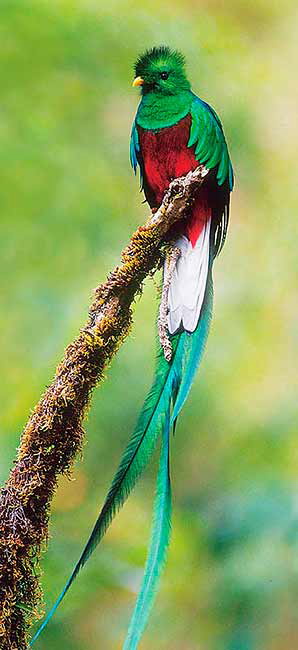 We doubt we'll see or catch as many ruby-throats in Guastatoya as we do in Guanacaste Province, Costa Rica--after all, Aloe Vera fields there may be the densest concentration for the species in all of Central America--but we won't know until we try. We doubt we'll see or catch as many ruby-throats in Guastatoya as we do in Guanacaste Province, Costa Rica--after all, Aloe Vera fields there may be the densest concentration for the species in all of Central America--but we won't know until we try.
Unlike our Costa Rican and Belizean expeditions that are based entirely at one locale, during the Guatemalan excursion we will take a mid-week overnight field trip by bus to Coban, about two hours northwest of Casa Guastatoya. This excursion will allow us to get out of town and into a Guatemalan cloud forest at Biotopo Del Quetzal. There we have very good chances of seeing a local population of Resplendent Quetzals, Guatemala's sought-after national bird (above right) considered by some to be "the most spectacular bird in the New World." In the early morning several quetzals come down the mountain to feed on wild avocados in the trees just behind the guest cabins. Thus, we'll ask the staff for a wake-up call "when the quetzals show up." Other birds we may see in the Biotopo include Highland Guan, Golden-browed Warbler, Slate-colored Solitaire, Blue-crowned Chlorophonia, Common Bush Tanager, Yellowish Flycatcher, Unicolored Jay, Slate-throated Redstart, Chestnut-headed Oropendola, and Emerald Toucanet.
The Guatemala trip is open to ANY adult interested in studying and reporting observations of hummingbirds in the tropics (and--after the trip--in the rest of Central America, Mexico, Canada, and/or the U.S.). You do NOT have to be an experienced birder or scientist or have advanced training; we will teach you everything you need to know to participate in the project.
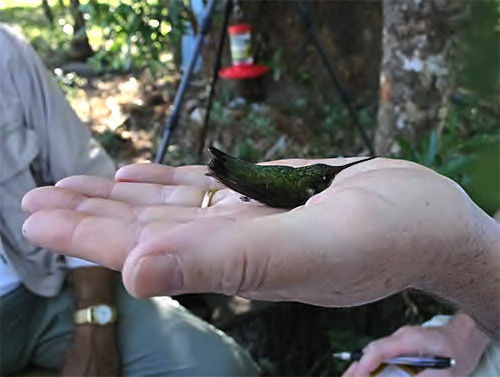
All text, maps & photos © Hilton Pond Center
Because making you a hummingbird bander is NOT the purpose of this particular trip, you will not actually be banding birds or removing them from nets. However, you WILL be involved in every other way: Handling and releasing multiple hummers (above) and other colorful tropical birds, deploying mist nets and traps, collecting and recording data, making valuable field observations, photographing flora and fauna, etc. You will NOT be disappointed!
Our 2011 expedition to Guatemalan wintering grounds of Ruby-throated Hummingbirds is scheduled for 20-28 February and immediately follows our trips to Costa Rica and Nicaragua. We especially encourage participation by K-12 teachers in allm of excursions and will be happy to collaborate with them on efforts to find grants to help underwrite trip costs and/or to work with home institutions if they seek graduate credit for the experience. (NOTE: There's also an option for a U.S. or Canadian teacher to travel and participate for FREE by recruiting 14 high school or college students for a special 7-, 8-, or 9-day trip; student trips can be scheduled anytime November through late February. Please contact us for details.)
After reading the itinerary and requirements below, please contact Debbie Sturdivant at Holbrook Travel (1-866-748-6146) if you have any questions about enrolling and/or to request enrollment forms. Register early to guarantee you can participate!
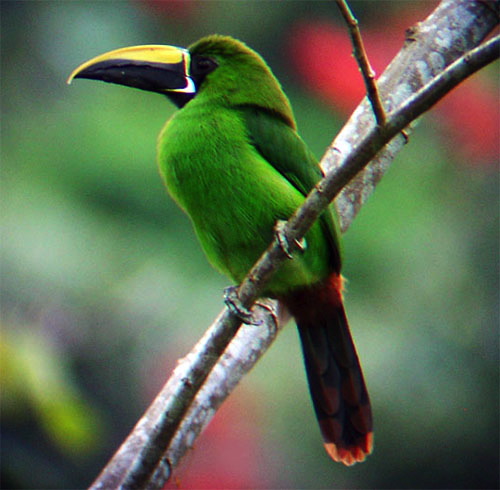
All text, maps & photos © Hilton Pond Center
GUATEMALA ITINERARY HIGHLIGHTS
- Observation, trapping/netting, and handling, banding & release of Ruby-throated Hummingbirds in the field
- Up-close in-hand examination of many migrant and resident Neotropical bird species (Emerald Toucanet, above)
- Half-day trip to Guatemala City to tour National Palace and to shop, eat & participate in local culture at Mercado Central
- Half-day trip to San Agustin/San Cristobal Acasaguastlan to view Colonial Baroque churches and other edifices
- Overnight visit to explore cloud forest at Biotopo del Quetzal and view tropical birds, flora, and habitats
- Opportunities for independent exploration and observation and photography of fascinating tropical plants and animals
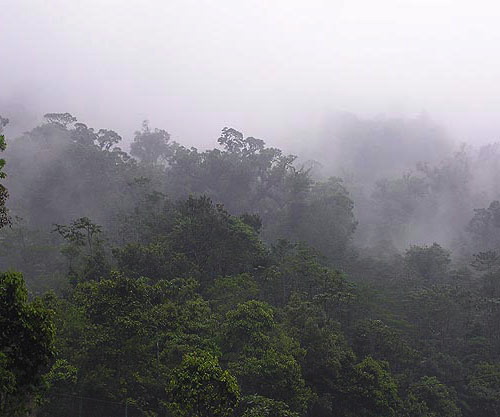
All text & photos © Hilton Pond Center
GUATEMALA EDUCATIONAL CONNECTIONS
- Hummingbird Observation & Banding
- Neotropical Migrant Bird Behavior
- In-hand Views of Non-migratory Tropical Birds
- Nocturnal Animal Behavior
- Biodiversity
- Cloud Forest Ecology (above)
- Landforms
- Conservation
- Nature Photography
- Pedagogical Field Techniques
- Research Field Techniques
- Guatemalan History & Culture
- Optional graduate credit is available through Weber State University (some trip costs may be deductible as educational expenses and/or be eligible for loans or scholarships from outside sources; teachers should ask principals and district offices if partial funding is available locally)
All text & photos © Hilton Pond Center
GUATEMALA ACTIVE ADVENTURES
(all optional; other opportunities may arise)
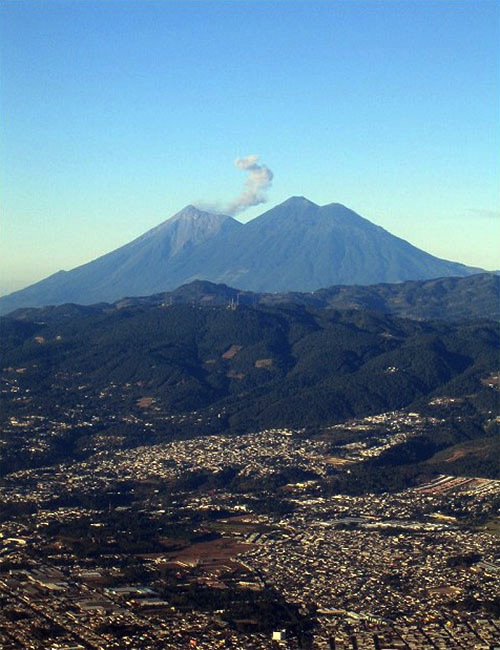
All text, maps & photos © Hilton Pond Center
-DETAILED ITINERARY for GUATEMALA-
20-28 Feb 2011
(Sunday through Monday of the following week)
DAY 1: February 20 (Sunday)--Arrival & Guastatoya
- Early Afternoon: Arrive at the recently renovated international airport in Guatemala City (above), greeted by trip leaders and guide; lunch on your own at airport. Transported by air-conditioned tour bus to Hotel Casa Guastatoya at Guastatoya. (NOTE: All flights must arrive before 3 p.m.; otherwise, plan to arrive a day early and overnight in Guatemala City.)
- Supper: At the hotel (occurs daily, unless otherwise noted).
- Evening: Introductions & Overview of Operation RubyThroat and methodologies to be used while monitoring, capturing & banding Ruby-throated Hummingbirds, Archilochus colubris.
DAY 2: February 21 (Monday)--Guastatoya & Day of Discovery
- Early Morning: Breakfast at the hotel (occurs daily, unless otherwise noted). Take air conditioned bus to study site for Day One of field work; make observations; scout for concentrations of hummingbirds; set traps and/or nets at various sites, including Aloe Vera plantations (below right) that may be one of the most important local habitats for wintering Ruby-throated Hummingbirds;
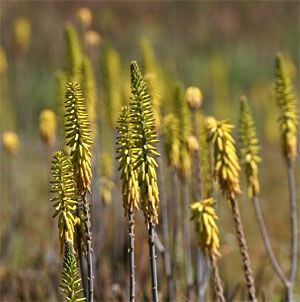 record data; band and release hummingbirds as captured. (NOTE: Most days we are at the study site by 7 a.m. and depart by 11:30 a.m.) record data; band and release hummingbirds as captured. (NOTE: Most days we are at the study site by 7 a.m. and depart by 11:30 a.m.)
- Lunch: Back at the hotel (occurs daily, unless otherwise noted).
- Afternoon: Explore Guastatoya on your own.
- Late Afternoon: Social gathering ("flocking behavior")
- Evening: Continuation of Operation RubyThroat discussions. Introduction to Guatemalan culture. Informal presentations by trip participants. (On at least one evening we hope to have opportunity for an optional night hike to observe nocturnal inhabitants of the Guastatoya region.)
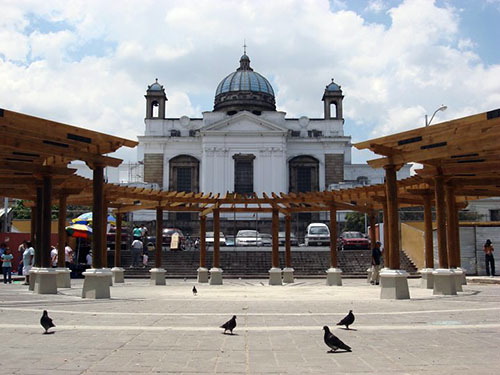
All text, maps & photos © Hilton Pond Center
DAY 3: February 22 (Tuesday)--Guastatoya; Guatemala City
- Early Morning: Day Two of hummingbird observations and banding at study site(s).
- Afternoon: Visit Guatemala City to see Relief Map of Guatemala, a massive scaled map and monument depicting many geographical features. Tour the National Palace, whose elaborate interior houses paintings and sculptures by famous Guatemalan artists. Walking tour of Central Park and Mercado Central (above, with Cathedral Metropolitana in background), a great shopping market for Guatemalan handicrafts, especially leather goods, woolen blankets, and masks.
- Late Afternoon: Social gathering.
- Evening: Continuation of Operation RubyThroat discussions. Informal presentations.
DAY 4: February 23 (Wednesday)--Guastatoya & Overnight to Coban (Biotopo del Quetzal) at Hotel Posada Del Quetzal
- Early Morning:
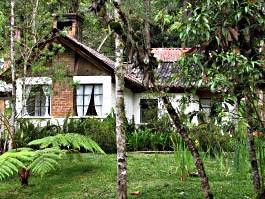 Day Three of hummingbird observations and banding at study site(s). Day Three of hummingbird observations and banding at study site(s).
- Late Morning/Afternoon: Lunch at Guastatoya, then depart via air conditioned bus for two-hour ride northwest to Coban and Biotopo del Quetzal. Lodging at Hotel Posada Del Quetzal (above right; room sharing may be required because of limited space at this special facility).
- Late Afternoon: Initial exploration of cloud forest (as time allows).
- Evening: Continuation of Operation RubyThroat discussions. Informal presentations. Possible night hike.

All text, maps & photos © Hilton Pond Center
DAY 5: February 24 (Thursday)--"Hump Day" at Coban (Biotopo del Quetzal) & Return to Guastatoya
- Early Morning: Arise when local guides hopefully tell us the Resplendent Quetzals have moved down the mountain to our cabins at Posada Montana Dekl Quetzal.
- Morning thru Early Afternoon: Breakfast & lunch at lodge. Explore cloud forest (above) with local guide and quietly stalk wildlife for unforgettable photos. Animals in the Biotopo reserve include small lizards, pizotes (White-nosed Coatis, right), wild cats, monkeys, and many bird species.
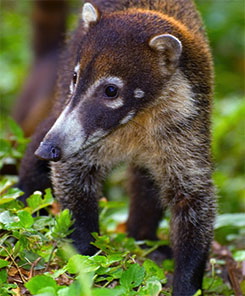 Visit orchid nursery as time allows. Visit orchid nursery as time allows.
- Mid-Afternoon: Depart Coban via bus for Guastatoya. Supper at hotel.
- Evening: Continuation of Operation RubyThroat discussions. Informal presentations.
DAY 6: February 25 (Friday)--Guastatoya
- Early Morning: Day Four of hummingbird observations and banding at study site(s).
- Afternoon: Explore Guastatoya on your own.
- Late Afternoon: Social gathering.
- Evening: Continuation of Operation RubyThroat discussions. Informal presentations.
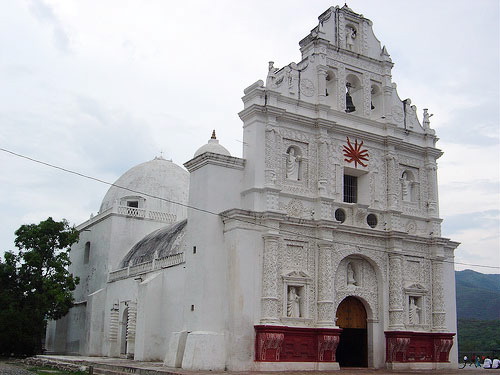
All text, maps & photos © Hilton Pond Center
DAY 7: February 26 (Saturday)--Guastatoya; San Agustín & San Cristóbal Acasaguastlán
- Early Morning: Day Five of hummingbird observations and banding at study site(s).
- Afternoon: Visit to San Agustín And San Cristóbal Acasaguastlán, two communities famous for religious and cultural structures from the Spanish Colonial Era. For example, the ornate facade of the church of San Cristóbal (above) was constructed by 1654 and has since been restored.
- Late Afternoon:
 Social gathering. Social gathering.
- Evening: Continuation of Operation RubyThroat discussions. Informal presentations.
DAY 8: February 27 (Sunday)--Guastatoya
- Early Morning: Day Six of hummingbird observations and banding at study site(s) (road to aloe field, right).
- Afternoon: Explore Guastatoya on your own. Begin packing for next day's departure.
- Late Afternoon: Social gathering.
- Evening: Final analysis of hummingbird data & "Farewell Fiesta."
DAY 9: February 28 (Monday)--Guastatoya & Departure
- Morning: Depart for Guatemala City airport for flight home (hugs optional but likely among new friends).
- Evening: Dream in your own hometown bed about hummingbirds and warm, sunny Guatemala!
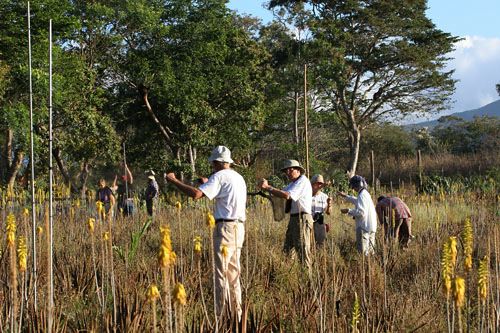
All text, maps & photos © Hilton Pond Center
The main purpose of any Operation RubyThroat expedition to the Neotropics is to learn about Ruby-throated Hummingbird "winter" behavior; thus, your active participation in making daily observations and collecting data is critical to the trip's success. A working pair of good binoculars is the only required equipment. We expect you to take initiative, carry your share of the load, and listen to and follow instructions carefully. We also expect you to look out for each other's needs and to be considerate of the hummingbirds we work with. We will have many wonderful and enjoyable experiences together, but this is NOT a pleasure trip--even though you'll have plenty of free time and are certain to have fun.
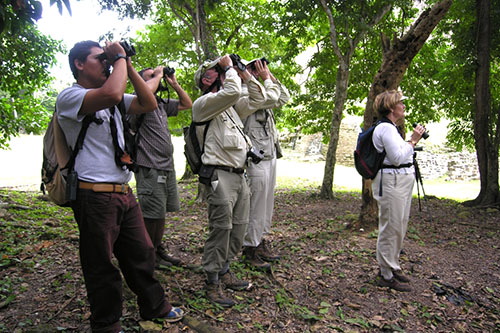
All text, maps & photos © Hilton Pond Center
If you are NOT willing to work hard in the field all week and follow the expedition's research and education goals, this is not a trip for you; we NEED your help and our success will depend on you. Days typically involve early through late-morning field activity under warm to hot conditions and after-supper meetings, with most afternoons open for you to do as you wish. Scheduled activities are subject to change due to weather or to take advantage of unexpected learning and research opportunities, but we'll do everything we can to make sure we offer all non-research activities described above.
GUATEMALA EXPEDITION LEADERS
BILL HILTON JR. (below left), internationally known educator-naturalist, was twice named South Carolina Science Teacher of the Year and was honored as the state's Outstanding Biology Teacher. In 1998, The Charlotte Observer named him a Carolinas "Guardian of the Environment" for a lifetime of trend-setting work in conservation and environmental education. 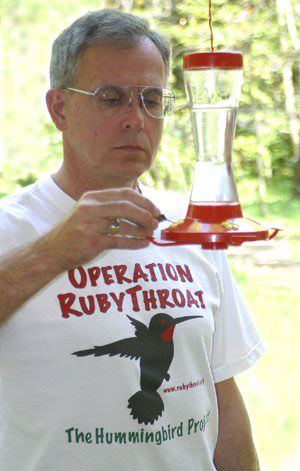 He has led ten highly successful hummingbird expeditions to Costa Rica and one to Belize. The December 2008 issue of Discover magazine cited Hilton as one of the top ten amateur scientists in America and one of the nation's "50 Best Brains in Science." He has led ten highly successful hummingbird expeditions to Costa Rica and one to Belize. The December 2008 issue of Discover magazine cited Hilton as one of the top ten amateur scientists in America and one of the nation's "50 Best Brains in Science."
Hilton is executive director of Hilton Pond Center for Piedmont Natural History. As principal investigator for "Operation RubyThroat: The Hummingbird Project," he received a 42-month grant from the National Science Foundation to integrate Operation RubyThroat with The GLOBE Program. Since 1982, Hilton has banded more than 54,000 birds at Hilton Pond, including 4,000-plus Ruby-throated Hummingbirds.
Hilton taught in Rock Hill and Fort Mill SC high schools, and at the University of Minnesota, St. Olaf College, and Winthrop University. He helped start the residential South Carolina Governor’s School for Science and Mathematics in Hartsville, which he served as biology instructor and director of student research.
Hilton is a nationally sought-after speaker on diverse natural history topics. He has a Bachelor of Arts in Philosophy from Newberry College, which he served as president of the Alumni Association. In this role, he organized a major international symposium on John Bachman, founder of Newberry College and a contemporary of John James Audubon. Hilton earned a Master of Arts in Biology Teaching from Winthrop University, and a Master of Science in Ecology & Behavioral Biology from the University of Minnesota, where he conducted a four-year field study of the behavioral ecology of Blue Jays, Cyanocitta cristata. For a complete resume, see his Biographical Sketch.
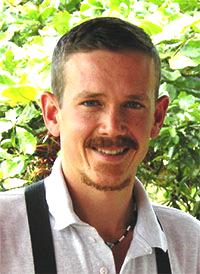 Hilton and the group will be assisted by ERNESTO M. CARMAN JR. of Talamanca Hawkwatch and Programa Conservacion de Aves. Ernesto (at right), a native-born Costa Rican (tico), speaks fluent English and Spanish, and is one of only a few naturalists with extensive experience observing Ruby-throated Hummingbirds within Costa Rica. Ernesto's sharp eyes and ears, comprehensive knowledge, and terrific personality greatly enrich our time in the field. After six years of involvement with the project he is a true collaborator and not just an in-country guide. Ernesto's family runs Finca Cristina, an environmentally friendly coffee farm that uses shade-grown organic techniques and recycles processing materials. Hilton and the group will be assisted by ERNESTO M. CARMAN JR. of Talamanca Hawkwatch and Programa Conservacion de Aves. Ernesto (at right), a native-born Costa Rican (tico), speaks fluent English and Spanish, and is one of only a few naturalists with extensive experience observing Ruby-throated Hummingbirds within Costa Rica. Ernesto's sharp eyes and ears, comprehensive knowledge, and terrific personality greatly enrich our time in the field. After six years of involvement with the project he is a true collaborator and not just an in-country guide. Ernesto's family runs Finca Cristina, an environmentally friendly coffee farm that uses shade-grown organic techniques and recycles processing materials.

All text, maps & photos © Hilton Pond Center

2011 GUATEMALA LAND PROGRAM COST: $1,595
(Please e-mail Wendy Frazier, Holbrook Travel's air specialist, for international airfare rates from your city. Holbrook often has access to "add-on" airfare at rates cheaper than those available to the general public. Holbrook can also arrange trip extensions before or after the Operation RubyThroat expedition.)
NOTE: Alumni of any Holbrook Professional Development Expedition--including past Operation RubyThroat trips to Costa Rica & Belize--are eligible for a $150 discount for any and all of the 2011 Operation RubyThroat excursions.
--Rates are based on: Double occupancy with a full roster of 12 participants and subject to increase with fewer participants. (Any participant may select a single room for an additional $100, but we recommend doubling as part of the community experience.)
--Participants must be: At least 21 years of age by the time the trip begins, and willing and able to participate in field work and all education and research activities. (Special consideration may be given on a case-by-case basis for college students and for advanced, mature senior high school students accompanied by a parent. We also can offer a full week in Central America for a class of 12-14 responsible high school or college students almost any time between November and late February; the sponsoring teacher earns a FREE trip. Please contact us for details.)
--Each participant must: Bring and know how to use a decent pair of binoculars with which to make field observations. Sharing binoculars doesn't work.
--Participants must be: In good physical & mental health and able to walk at slow to moderate pace for short distances (usually less than a half mile) over level to hilly terrain at the study site, and be able to carry light objects in the field (mist net poles, banding tools, day pack, etc.). 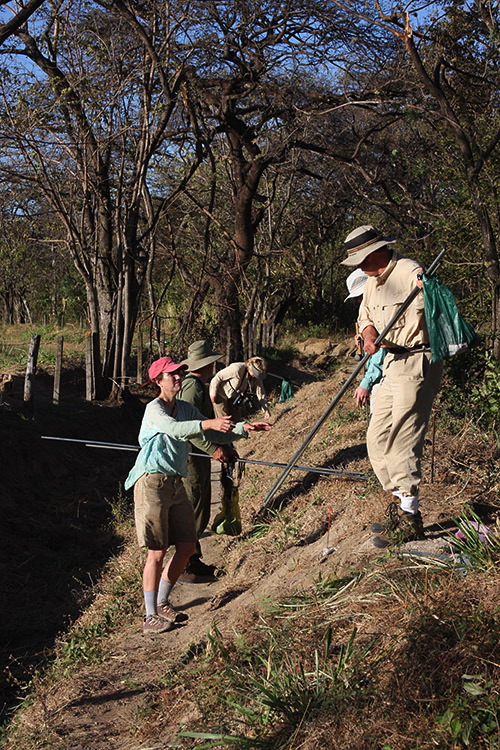 Participants may need to stand for extended periods (up to 60 minutes) to monitor nets under sunny conditions, with opportunities for water breaks in the shade. On past expeditions, participants as old as 80 have had no problems with the minimal physical demands of the project. Participants may need to stand for extended periods (up to 60 minutes) to monitor nets under sunny conditions, with opportunities for water breaks in the shade. On past expeditions, participants as old as 80 have had no problems with the minimal physical demands of the project.
--Program cost includes: All in-country transportation, accommodations, meals, expert local guide (bilingual), learning activities and field trips, and Operation RubyThroat instructional materials, as stated above.
--Program cost does not include: International airfare (about $500-$750, depending on departure point; use frequent flyer miles if you can); meals, if any, away from the hotel; any additional optional activities not described above; non-mealtime beverages or snacks; estimated $30 deparure tax; gratuities for guide, driver, and local personnel; or optional graduate credit costs. (Please note that because of difficulty with international connections and depending on your point of origin, it may be necessary for you to spend an extra night traveling to and/or from Guatemala City.)
--Payment policy: To confirm your space, send $200 deposit per person to Holbrook Travel along with your enrollment form(s); deposit for all trips is due on or before 23 September 2010. We suggest early deposit to guarantee your space. Each deposit is refundable minus a $100 processing fee if cancellation is received by 16 November 2010; there will be no refunds for cancellations after that date. Final payment of $1,399 is due on 17 November 2010. (We strongly advise inexpensive third-party trip insurance to cover unexpected circumstances that could cause you to cancel after your final payment is made; such insurance can also cover flight delays and related land transportation, in-country medical care, etc.)
--Pre-trip activities: We will communicate with you frequently via e-mail in the weeks leading up to your trip. You'll also receive suggested readings and resources that will enhance your trip experience. We anticipate you will study and learn all important information related to the trip's research goals.
--Optional graduate credit: Contact Holbrook Travel's Debbie Sturdivant for information about how to apply and pay for graduate credit through Weber State University. You may also elect to work with your local college to earn credit there. K-12 educators may file for continuing education credits.
--Tax deductions: Because Operation RubyThroat expeditions are service projects in support of a non-profit, an estimated $400 of your fees should be tax-deductible on your 2010 tax forms. 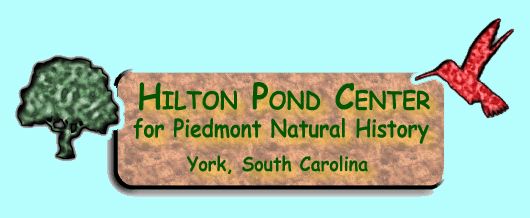 If you are participating as part of a college degree program or are a classroom teacher, additional tax deductions may be taken--in fact, the FULL COST of the trip may be deductible. (In some cases, this means after taxes the trip actually will end up costing you nothing!) If you are participating as part of a college degree program or are a classroom teacher, additional tax deductions may be taken--in fact, the FULL COST of the trip may be deductible. (In some cases, this means after taxes the trip actually will end up costing you nothing!)
Hilton Pond Center for Piedmont Natural History and Operation RubyThroat: The Hummingbird Project expeditions are non-profit trips offered as outreach activities through which we learn more about winter behavior of Ruby-throated Hummingbirds. If you're interested in making a separate contribution to the Center and/or Operation RubyThroat, please see Supporting the Work of Hilton Pond Center.
After reading the information above, contact Debbie Sturdivant at Holbrook Travel by E-mail or phone (1-866-748-6146) if you have any questions about enrolling and/or to request enrollment forms. See you in Guatemala!

Adult female Ruby-throated Hummingbird (above),
captured for banding
All text & photos © Hilton Pond Center
Thanks to Dr. Tom Carr of Holbrook Travel for Guastatoya study site photos
For complete reports on all our successful Neotropical hummingbird banding expeditions, please visit
"This Week at Hilton Pond" at the following links:
|
|
|
|
|
|
|
|
|
|
|
|
|
|
|
|



 are the most widely distributed hummingbird species. Nonetheless, they are poorly studied in Mexico and Central America where they spend their non-breeding months. During our 2011 nine-day field trip to Guastatoya in Guatemala's Progreso Province, Center director Bill Hilton Jr. will teach participants how hummingbirds are observed, captured, banded, and released. As "citizen scientists," participants will play integral roles in conducting field work, will visit diverse habitats, and will learn about fascinating aspects of Guatemalan natural history and culture--from cloud forests to semi-arid valleys, from nocturnal mammals to tropical insects.
are the most widely distributed hummingbird species. Nonetheless, they are poorly studied in Mexico and Central America where they spend their non-breeding months. During our 2011 nine-day field trip to Guastatoya in Guatemala's Progreso Province, Center director Bill Hilton Jr. will teach participants how hummingbirds are observed, captured, banded, and released. As "citizen scientists," participants will play integral roles in conducting field work, will visit diverse habitats, and will learn about fascinating aspects of Guatemalan natural history and culture--from cloud forests to semi-arid valleys, from nocturnal mammals to tropical insects.




 We doubt we'll see or catch as many ruby-throats in Guastatoya as we do in Guanacaste Province, Costa Rica--after all, Aloe Vera fields there may be the densest concentration for the species in all of Central America--but we won't know until we try.
We doubt we'll see or catch as many ruby-throats in Guastatoya as we do in Guanacaste Province, Costa Rica--after all, Aloe Vera fields there may be the densest concentration for the species in all of Central America--but we won't know until we try.



 record data; band and release hummingbirds as captured. (NOTE: Most days we are at the study site by 7 a.m. and depart by 11:30 a.m.)
record data; band and release hummingbirds as captured. (NOTE: Most days we are at the study site by 7 a.m. and depart by 11:30 a.m.)

 Day Three of hummingbird observations and banding at study site(s).
Day Three of hummingbird observations and banding at study site(s).

 Visit orchid nursery as time allows.
Visit orchid nursery as time allows.

 Social gathering.
Social gathering.


 He has led ten highly successful hummingbird expeditions to Costa Rica and one to Belize. The December 2008 issue of Discover magazine cited Hilton as one of the top ten amateur scientists in America and one of the nation's "50 Best Brains in Science."
He has led ten highly successful hummingbird expeditions to Costa Rica and one to Belize. The December 2008 issue of Discover magazine cited Hilton as one of the top ten amateur scientists in America and one of the nation's "50 Best Brains in Science." Hilton and the group will be assisted by ERNESTO M. CARMAN JR. of Talamanca Hawkwatch and Programa Conservacion de Aves. Ernesto (at right), a native-born Costa Rican (tico), speaks fluent English and Spanish, and is one of only a few naturalists with extensive experience observing Ruby-throated Hummingbirds within Costa Rica. Ernesto's sharp eyes and ears, comprehensive knowledge, and terrific personality greatly enrich our time in the field. After six years of involvement with the project he is a true collaborator and not just an in-country guide. Ernesto's family runs
Hilton and the group will be assisted by ERNESTO M. CARMAN JR. of Talamanca Hawkwatch and Programa Conservacion de Aves. Ernesto (at right), a native-born Costa Rican (tico), speaks fluent English and Spanish, and is one of only a few naturalists with extensive experience observing Ruby-throated Hummingbirds within Costa Rica. Ernesto's sharp eyes and ears, comprehensive knowledge, and terrific personality greatly enrich our time in the field. After six years of involvement with the project he is a true collaborator and not just an in-country guide. Ernesto's family runs 
 Participants may need to stand for extended periods (up to 60 minutes) to monitor nets under sunny conditions, with opportunities for water breaks in the shade. On past expeditions, participants as old as 80 have had no problems with the minimal physical demands of the project.
Participants may need to stand for extended periods (up to 60 minutes) to monitor nets under sunny conditions, with opportunities for water breaks in the shade. On past expeditions, participants as old as 80 have had no problems with the minimal physical demands of the project. If you are participating as part of a college degree program or are a classroom teacher, additional tax deductions may be taken--in fact, the FULL COST of the trip may be deductible. (In some cases, this means after taxes the trip actually will end up costing you nothing!)
If you are participating as part of a college degree program or are a classroom teacher, additional tax deductions may be taken--in fact, the FULL COST of the trip may be deductible. (In some cases, this means after taxes the trip actually will end up costing you nothing!)


 You can also
You can also